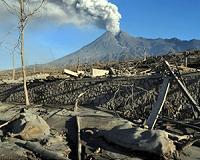| . |  |
. |
Sukoharjo, Indonesia (AFP) Nov 15, 2010 With their belongings piled on to motorcycles and pickup trucks, thousands of Indonesian families returned home on Monday after fleeing deadly volcanic eruptions from Mount Merapi. Scientists warned, however, that the nation's most active volcano remained a severe threat, as more bodies were found buried in the mountains of ash blasted out from Mount Merapi since late last month, bringing the death toll to 259. "The eruption process is still ongoing but the intensity has reduced significantly. The status is still alert," volcanologist Subandrio told AFP. More than 30,000 people have left emergency shelters since the government at the weekend reduced a 20-kilometre (12-mile) exclusion zone around the volcano by as much as half in some districts. Search teams pulled another 17 bodies from the ash that seared swathes of the central Javan countryside in a series of eruptions from Mount Merapi starting on October 26. Whole families crammed on to motorcycles for the journey home, with feelings of relief at the chance to leave the overcrowded camps mixed with trepidation about the state of their properties, crops and livestock in the villages. In the newly designated safe village of Sukoharjo on the southern slopes of the mountain, 57-year-old Sukirah was already replanting her paddy field a day after returning home. "I'm happy to come back home. At least I can start to live normally," she told AFP. "But I couldn't sleep last night. The eruption still haunts me. I'm traumatised by what happened. Every time I see the mountain spewing ash, I feel terrible like I want to run away." Disaster Management Agency spokesman Sutopo Purwo Nugroho said 365,089 people were still living in shelters Monday, about 30,000 fewer than on Sunday. "We expect more to go home today," he added. The death toll rose as teams reached deeper into the danger zone and found the dead strewn in the grey ash where they had been caught in blistering jets of gas and rock known as pyroclastic flows. Most of the 259 dead perished when the volcano, a sacred landmark in Javanese tradition whose name translates as "Mountain of Fire", exploded on November 5 in its biggest eruption in more than a century. Merapi spewed clouds of gas and ash as high as four kilometres Sunday but volcanologist Subandrio said this was "small compared to the 14 kilometres in previous days". "It's safe for people to go home as long as they stay outside the danger zone," he added. The government has maintained the 20-kilometre danger zone for Sleman district, on the southern slopes of the mountain, as "there's still a probability of heat clouds going in that direction", he said. The airport at Yogyakarta, the capital of Central Java province, has been closed for almost a week because of the threat of ash to passing aircraft, affecting dozens of domestic and international flights. Airport officials said conditions were being reviewed on a daily basis. Merapi is one of dozens of active volcanoes on the archipelago that straddles major tectonic fault lines known as the "ring of fire" between the Pacific and Indian oceans. It killed around 1,300 people in 1930 but experts say the current eruptions are its biggest since 1872.
Share This Article With Planet Earth
Related Links Bringing Order To A World Of Disasters When the Earth Quakes A world of storm and tempest
 Indonesians ignore volcano threat to go home
Indonesians ignore volcano threat to go homeSukoharjo, Indonesia (AFP) Nov 15, 2010 With their belongings piled on to motorcycles and pickup trucks, thousands of Indonesian families returned home on Monday after fleeing deadly volcanic eruptions from Mount Merapi. Scientists warned however that the nation's most active volcano remained a severe threat, as more bodies were found buried in the mountains of ash blasted out from Mount Merapi since late last month, bringing the ... read more |
|
| The content herein, unless otherwise known to be public domain, are Copyright 1995-2010 - SpaceDaily. AFP and UPI Wire Stories are copyright Agence France-Presse and United Press International. ESA Portal Reports are copyright European Space Agency. All NASA sourced material is public domain. Additional copyrights may apply in whole or part to other bona fide parties. Advertising does not imply endorsement,agreement or approval of any opinions, statements or information provided by SpaceDaily on any Web page published or hosted by SpaceDaily. Privacy Statement |